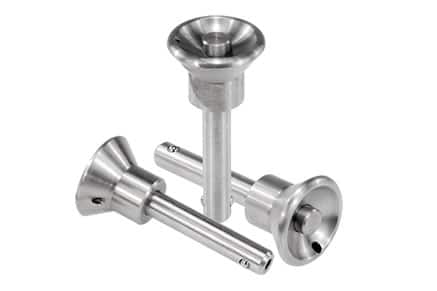
When you’re utilizing advanced stainless steel CNC machining for manufacturing, using manual techniques and employing costly labor for deburring is not feasible.
Deburring smaller parts with swarming stainless pins can automate deburring of smaller parts, process medium to large-size batches and save a lot of time and resources. The process is highly recommended for parts produced using
stainless steel CNC machining. It effectively removes light burrs from stainless steel machined parts and various other metal parts.
Table of Contents
Why Deburr Small Parts with Swarming Stainless Pins?
Traditional deburring techniques are ineffective for smaller parts. For instance, conventional tumbling media can’t deburr parts with complex design features. And if you’re using labor-intensive methods, the results are not optimum, the costs go up, and the overall production time is affected. Therefore, deburring small parts with swarming stainless pins becomes a practical and efficient option.
Here’s why you should deburr small parts with swarming stainless pins;
Precision Efficiency: This technique allows you to ensure the finest quality in small parts. The deburring stainless pins are usually 0.2 mm to 1.5 mm in diameter. They can remove burrs from complex part features (Blind holes, through and cross holes, etc.) that are practically unreachable.
Automatic time saving: Deburring cycle for small to medium size batch is only about 10 minutes long. It is the fastest process to deburr small parts. Plus, it doesn’t require labor intervention during the process.
Usability Variety: The method can be used for a variety of metal parts such as CNC stainless steel, aluminum, brass, beryllium, and copper. It is also usable for titanium if the burrs are lighter. Moreover, the method doesn’t require skilled manpower.
Highly Cost Effective: Implementing this method doesn require a hefty capital investment. The deburring system comes as a whole. The stainless pins could be used for 3 to 5 years and replaced easily. The maintenance and
repair are also budget-friendly.
It is preferred to use this technique specifically for smaller parts. The results will surely improve product quality, reduce post-production or finishing costs, and save time. This simple method will prove to be a game changer.
A step-by-step guide to Deburr Small Parts with Swarming Stainless Pins
This technique uses magnetism to spin stainless pins in a container; therefore, it is often referred to as magnetic deburring. A magnetic deburring machine is employed to polish and deburr metal parts. The deburring cycle involves three simple steps.
The entire process takes about 5-to-10 minutes to complete.
Step 1: Fill the container with stainless pins to the appropriate level, depending on the quantity of parts. Then add the parts to the container.
Step 2: The next step is to add the deburring solution. It acts as a catalyst in the process. The solution lubricates the interaction between the stainless pins and the burrs. It allows the pins to detach easily and ensure effective deburring.
Step 3: The last step is to extract the parts from the container. It is usually completed using a strainer that separates parts from stainless pins.
The burrs are usually unavoidable when you’re CNC machining stainless steel to manufacture metal parts. Magnetic deburring is an effective technique to remove burrs from small parts without inflicting any damage.
How to Optimize Deburring of Smaller Parts with Swarming Stainless Pins?
Although deburring smaller parts with swarming stainless pins is an efficient technique, it can be further optimized to achieve the best results. You can raise the finishing quality of your products, control deburring time, and increase overall productivity. Here’s how;
Part material and geometry compatibility
Ensure the part material and its geometry is compatible with your deburring technique. If you’re not obtaining optimal results, try changing deburring media. For example, you can change the length of stainless pins to ensure proper coverage. In other cases, adjust the media-to-part ratio or the magnetic field strength. Find the balance; look for settings that are compatible with your parts.
Adjusting deburring time
Try not to haste the process. Set the deburring duration accordingly if you want the best finish in the parts. Longer deburring duration brings better results. However, you must avoid over-deburring; it can be disastrous. The part surface quality is highly affected by over-deburring. Therefore, keep it within the limits. The deburring time
varies from part to part; you must test what duration brings good results.
Role of deburring solutions
The deburring compound is not just for minimizing friction; it offers much more. A good deburring solution can ensure corrosion prevention and rust inhibition and even be used for surface cleaning. Moreover, if the solution has a required level of consistency, it can help remove burrs much faster. So, choose an effective deburring solution to optimize the deburring process.
Monitor for ultimate optimization.
If you closely monitor the process and keep track of deburring duration, media usage, and part quality, you’ll easily optimize the process. Make variations in various settings for improved efficiency and effectiveness. Identify the settings that help you achieve desired results. Make sure to keep track of different part types.
Conclusion
Producing parts by machining stainless steel, copper, or any other metal leaves burrs on part surfaces that are undesirable. Deburring small parts with swarming stainless pins is a promising solution to efficiently removing burrs. The advantages, such as cost-effectiveness, versatility, and ease of process implementation, are matchless. If
optimized, the process offers consistent and effective results.
Manufacturers can level up their products with impeccable finishing by implementing this technique. They can also increase productivity, save time, and reduce costs. It’s important to note that manufacturers should consider the specific requirements of their parts and then choose a deburring technique. Otherwise, the results may not be up to the mark.
